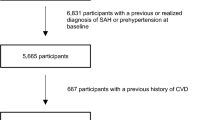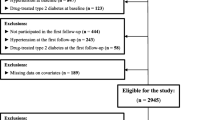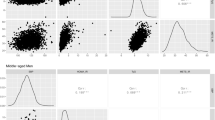Summary
Background
Metabolic syndrome refers to the association among several cardiovascular risk factors: obesity, dyslipidemia, hyperglycemia, and hypertension. It is associated with increased cardiovascular risk and the development of type 2 diabetes mellitus. Insulin resistance is the underlying mechanism of metabolic syndrome, although its role in increased cardiovascular risk has not been directly identified.
Objective
We investigated the association between insulin resistance and increased cardiovascular risk in hypertensive adults without diabetes mellitus.
Design and participants
We enrolled participants without diabetes from an outpatient setting in a retrospective, longitudinal study. Several demographic, clinical, and laboratory parameters were recorded during the observation period. Plasma insulin and homeostatic model assessment for insulin resistance (HOMA-IR) were used to determine insulin resistance and four cardiovascular events (acute coronary disease, acute cerebrovascular disease, incident heart failure, and cardiovascular mortality) were combined into a single outcome. Logistic regression and Cox proportional hazards models were fitted to evaluate the association between covariates and outcomes.
Results
We included 1899 hypertensive adults without diabetes with an average age of 53 years (51.3% women, 23% had prediabetes, and 64.2% had metabolic syndrome). In a logistic regression analysis, male sex (odds ratio, OR = 1.66) having high levels of low-density lipoprotein (LDL, OR = 1.01), kidney function (OR = 0.97), and HOMA-IR (OR = 1.06) were associated with the incidence of cardiovascular events; however, in a survival multivariate analysis, only HOMA-IR (hazard ratio, HR 1.4, 95% confidence interval, CI: 1.05–1.87, p = 0.02) and body mass index (HR 1.05, 95% CI: 1.02–1.08, p = 0.002) were considered independent prognostic variables for the development of incident cardiovascular events.
Conclusion
Insulin resistance and obesity are useful for assessing cardiovascular risk in hypertensive people without diabetes but with preserved kidney function. This work demonstrates the predictive value of the measurement of insulin, and therefore of insulin resistance, in an outpatient setting and attending to high-risk patients.


Similar content being viewed by others
References
James DE, Stöckli J, Birnbaum MJ. The aetiology and molecular landscape of insulin resistance. Nat Rev Mol Cell Biol. 2021;22(11):751–71. Nov.
Laakso M, Kuusisto J. Insulin resistance and hyperglycaemia in cardiovascular disease development. Nat Rev Endocrinol. 2014;10(5):293–302. May.
Fonseca VA. Defining and characterizing the progression of type 2 diabetes. Diabetes care. 2009 Nov;32 Suppl 2:S151–6.
Weyer C, Tataranni PA, Bogardus C, Pratley RE. Insulin Resistance and Insulin Secretory Dysfunction Are Independent Predictors of Worsening of Glucose Tolerance During Each Stage of Type 2 Diabetes Development. Diabetes Care. 2001;24(1):89–94.
UKPDS. U.K. Prospective Diabetes Study 16: Overview of 6 Years’ Therapy of Type II Diabetes: A Progressive Disease. Diabetes. 1995;44(11):1249–58.
Li M, Chi X, Wang Y, Setrerrahmane S, Xie W, Xu H. Trends in insulin resistance: insights into mechanisms and therapeutic strategy. Sig Transduct Target Ther. 2022;6;7(1):1–25. Jul.
King GL, Park K, Li Q. Selective Insulin Resistance and the Development of Cardiovascular Diseases in Diabetes: The 2015 Edwin Bierman Award Lecture. Diabetes. 2016;65(6):1462–71. Jun.
Ormazabal V, Nair S, Elfeky O, Aguayo C, Salomon C, Zuñiga FA. Association between insulin resistance and the development of cardiovascular disease. Cardiovasc Diabetol. 2018;31;17(1):122. Aug.
Reaven G. Insulin resistance and coronary heart disease in nondiabetic individuals. Arterioscler Thromb Vasc Biol. 2012;32(8):1754–9. Aug.
Zethelius B, Lithell H, Hales CN, Berne C. Insulin sensitivity, proinsulin and insulin as predictors of coronary heart disease. A population-based 10-year, follow-up study in 70-year old men using the euglycaemic insulin clamp. Diabetologia. 2005;48(5):862–7. May.
Wang T, Li M, Zeng T, Hu R, Xu Y, Xu M, et al. Association Between Insulin Resistance and Cardiovascular Disease Risk Varies According to Glucose Tolerance Status: A Nationwide Prospective Cohort Study. Diabetes Care. 2022;45(8):1863–72. Aug.
Ellulu MS, Patimah I, Khaza’ai H, Rahmat A, Abed Y. Obesity and inflammation: the linking mechanism and the complications. Arch Med Sci. 2017;13(4):851–63. Jun.
Scarpellini E, Tack J. Obesity and Metabolic Syndrome: An Inflammatory. Cond Ddi. 2012;30(2):148–53.
Garcia-Carretero R, Vigil-Medina L, Barquero-Perez O. The Use of Machine Learning Techniques to Determine the Predictive Value of Inflammatory Biomarkers in the Development of Type 2 Diabetes Mellitus. Metabolic Syndrome and Related Disorders [Internet]. 2021 Feb 16; Available from: https://doi.org/10.1089/met.2020.0139
Sarwar N, Aspelund T, Eiriksdottir G, Gobin R, Seshasai SRK, Forouhi NG, et al. Markers of dysglycaemia and risk of coronary heart disease in people without diabetes: Reykjavik prospective study and systematic review. Plos Med. 2010;7(5):e1000278. May.
Kahn SE, Hull RL, Utzschneider KM. Mechanisms linking obesity to insulin resistance and type 2 diabetes. Nature. 2006;14;444(7121):840–6. Dec.
Levey AS, Stevens LA, Schmid CH, Zhang YL, Castro AF, Feldman HI, et al. A new equation to estimate glomerular filtration rate. Ann Intern Med. 2009;150(9):604–12.
Unger T, Borghi C, Charchar F, Khan NA, Poulter NR, Prabhakaran D, et al. 2020 International Society of Hypertension Global Hypertension Practice Guidelines. Hypertension. 2020;75(6):1334–57. Jun.
Classification and Diagnosis of Diabetes: Standards of Medical Care in Diabetes—2018. Diabetes Care. 2018 Jan 1;41(Supplement 1):S13 LP–S27.
Executive summary of the third report of the national cholesterol education program (NCEP) expert panel on detection, evaluation and treatment of high blood cholesterol in adults (Adult Treatment Panel III), JAMA. 2001 May 16;285(19):2486–97.
R Core Team. A Language and Environment for Statistical Computing [Internet]. Vienna, Austria. Available from: https://www.r-project.org: R Foundation for Statistical Computing; 2020.
Bradburn MJ, Clark TG, Love SB, Altman DG. Survival analysis part II: multivariate data analysis—an introduction to concepts and methods. Br J Cancer. 2003;4;89(3):431–6. Aug.
Clark TG, Bradburn MJ, Love SB, Altman DG. Survival analysis part I: basic concepts and first analyses. Br J Cancer. 2003;89(2):232–8. Jul.
Allen M, Poggiali D, Whitaker K, Marshall TR, Kievit RA. Raincloud plots: a multi-platform tool for robust data visualization. Wellcome Open Res. 2019;1;4:63–63. Apr.
Lakka HM, Salonen JT, Tuomilehto J, Kaplan GA, Lakka TA. Obesity and weight gain are associated with increased incidence of hyperinsulinemia in non-diabetic men. Horm Metab Res. 2002;34(9):492–8. Sep.
Ye J. Mechanisms of insulin resistance in obesity. Front Med. 2013;7(1):14–24. Mar.
Ye J. Role of insulin in the pathogenesis of free fatty acid-induced insulin resistance in skeletal muscle. Endocr Metab Immune Disord Drug Targets. 2007;7(1):65–74. Mar.
Ye J, McGuinness OP. Inflammation during obesity is not all bad: evidence from animal and human studies. Am J Physiol Endocrinol Metab. 2013;304(5):E466–77. Mar.
Lau DCW, Dhillon B, Yan H, Szmitko PE, Adipokines VS. molecular links between obesity and atheroslcerosis. Am J Physiol Heart Circ Physiol. 2005;288(5):H2031–41. May.
Cinti S, Mitchell G, Barbatelli G, Murano I, Ceresi E, Faloia E, et al. Adipocyte death defines macrophage localization and function in adipose tissue of obese mice and humans. J Lipid Res. 2005;46(11):2347–55. Nov.
Halberg N, Wernstedt-Asterholm I, Scherer PE. The adipocyte as an endocrine cell. Endocrinology and metabolism clinics of North America. 2008 Sep;37(3):753–68, x–xi.
Grundy SM, Cleeman JI, Daniels SR, Donato KA, Eckel RH, Franklin BA, et al. Diagnosis and management of the metabolic syndrome: an American Heart Association/National Heart, Lung, and Blood Institute Scientific Statement. Circulation. 2005;112(17):2735–52.
Alberti K, Eckel RH, Grundy SM, Zimmet PZ, Cleeman JI, Donato KA, et al. Harmonizing the Metabolic Syndrome A Joint Interim Statement of the International Diabetes Federation Task Force on Epidemiology and Prevention; National Heart, Lung, and Blood Institute; American Heart Association; World Heart Federation; International A. Circulation. 2009;120(16):1640–5.
Haidara M, Mikhailidis DP, Yassin HZ, Dobutovic B, Smiljanic KT, Soskic S, et al. Evaluation of the possible contribution of antioxidants administration in metabolic syndrome. Curr Pharm Des. 2011;17(33):3699–712. Nov.
Gluvic Z, Zaric B, Resanovic I, Obradovic M, Mitrovic A, Radak D, et al. Link between Metabolic Syndrome and Insulin Resistance. Curr Vasc Pharmacol. 2017;15(1):30–9.
Stokić E, Kupusinac A, Tomić-Naglić D, Zavišić BK, Mitrović M, Smiljenić D, et al. Obesity and vitamin D deficiency: trends to promote a more proatherogenic cardiometabolic risk profile. Angiology. 2015;66(3):237–43. Mar.
Emerging Risk Factors Collaboration, Kaptoge S, Di Angelantonio E, Lowe G, Pepys MB, Thompson SG, et al. C‑reactive protein concentration and risk of coronary heart disease, stroke, and mortality: an individual participant meta-analysis. Lancet. 2010;9;375(9709):132–40. Jan.
Ridker PM. From C‑Reactive Protein to Interleukin‑6 to Interleukin-1: Moving Upstream To Identify Novel Targets for Atheroprotection. Circ Res. 2016;8;118(1):145–56. Jan.
DeFronzo RA. Insulin resistance, lipotoxicity, type 2 diabetes and atherosclerosis: the missing links. The Claude Bernard Lecture 2009. Diabetologia. 2010;53(7):1270–87. Jul.
Matthews DR, Hosker JP, Rudenski AS, Naylor BA, Treacher DF, Turner RC. Homeostasis model assessment: insulin resistance and β‑cell function from fasting plasma glucose and insulin concentrations in man. Diabetologia. 1985;1;28(7):412–9. Jul.
Stern SE, Williams K, Ferrannini E, DeFronzo RA, Bogardus C, Stern MP. Identification of individuals with insulin resistance using routine clinical measurements. Diabetes. 2005;54(2):333–9. Feb.
Gayoso-Diz P, Otero-González A, Rodriguez-Alvarez MX, Gude F, García F, De Francisco A, et al. Insulin resistance (HOMA-IR) cut-off values and the metabolic syndrome in a general adult population: effect of gender and age: EPIRCE cross-sectional study. BMC Endocr Disord. 2013;16;13:47. Oct.
Lamounier-Zepter V, Ehrhart-Bornstein M, Bornstein SR. Insulin resistance in hypertension and cardiovascular disease. Best Pract Res Clin Endocrinol Metab. 2006;20(3):355–67. Sep.
Eddy D, Schlessinger L, Kahn R, Peskin B, Schiebinger R. Relationship of insulin resistance and related metabolic variables to coronary artery disease: a mathematical analysis. Diabetes Care. 2009;32(2):361–6. Feb.
Funding
The authors received no financial support for this research or the authorship or publication of this article.
Author information
Authors and Affiliations
Contributions
Dr. Garcia-Carretero designed and conceived the study, preprocessed the data, analyzed and interpreted the data, and wrote the first draft of the article. Dr. Vazquez-Gomez made substantial contributions to the interpretation of the results, critically reviewed the first draft of the manuscript, and made valuable suggestions. Drs. Gil-Prieto and Gil-de-Miguel supervised the project and critically reviewed and edited the final draft of the manuscript. All authors read and approved the final manuscript.
Corresponding author
Ethics declarations
Conflict of interest
R. Garcia-Carretero, O. Vazquez-Gomez, R. Gil-Prieto and A. Gil-de-Miguel declare that they have no competing interests.
Ethical standards
This retrospective study was approved by the Research and Ethics Committee of Mostoles University Hospital. All procedures involving human participants were conducted in accordance with the ethical standards of the responsible institutional and/or National Research Committee and with the tenets of the 1964 Helsinki Declaration and its later amendments and comparable ethical standards. The authors obtained consent for publication from their institution and its Research and Ethics Committee.
Additional information
Publisher’s Note
Springer Nature remains neutral with regard to jurisdictional claims in published maps and institutional affiliations.
Data availability
According to the terms of a contract signed with Mostoles University Hospital, the authors cannot provide the dataset to any other researcher. Furthermore, it was destroyed at the conclusion of the research.
Rights and permissions
About this article
Cite this article
Garcia-Carretero, R., Vazquez-Gomez, O., Gil-Prieto, R. et al. Insulin resistance is a cardiovascular risk factor in hypertensive adults without type 2 diabetes mellitus. Wien Klin Wochenschr 136, 101–109 (2024). https://doi.org/10.1007/s00508-023-02278-1
Received:
Accepted:
Published:
Issue Date:
DOI: https://doi.org/10.1007/s00508-023-02278-1




